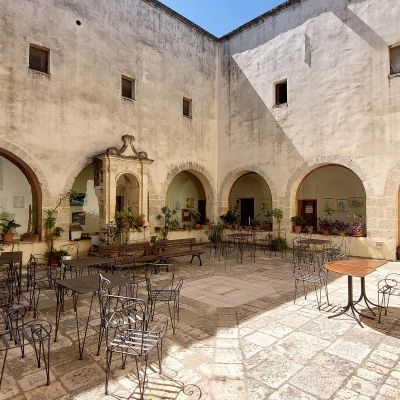Church of Saint Mary of Stigliano and Monastery of the Capuchins
The Capuchin friars arrived in Mesagne in the 16th century at the request of the archpriest Lucantonio Resta and they remained until 1866. The friars were granted the church of Saint Mary of Stigliano. The benefits of the monastery, which had the title of abbey, were the object of dispute between the abbots and the various feudal lords during the 1500s.
The monastery was built on the left side of the church of Saint Mary of Stigliano around the 1550s while the church took on its current appearance around 1630 during the Albricci family dynasty. Their crest can still be seen today on the facade.
A document from 1668 chronicles some work carried out in the choir of the church by the master engineer Giuseppe Profilo at the bequest of Francesco Selvaggio. Another testimony emerges on the 26th June 1638 when the noblewoman Maria Vasques de Ummana, the wife of the tax collector of the feudal estate of Mesagne, Samuele Bieruliet, asks to be buried in the church of the Capuchins and gives a donation of fifty ducats to the monastery. Today, it is possible to see on the slab of her tomb housed in the headquarters of the local authority, “ex Convento dei Celestini”.
The royal engineer Pietro Vinaccia’s description of the monastery in 1731 is very important. Vinaccia describes the church with five chapels, two on the right side, with wooden altars: the first dedicated to the Blessed Virgin of Stigliano, the second entitled the “Blessed Conception”. Of the three chapels on the left, again with wooden altars, the first is dedicated to the “wood from the sacred cross”, the second to Saint Biagio and the third to Saint Francis of Assisi. The main altar, once again in wood, is endowed with “ornamenti ed intagli” (carved ornaments) and an oil painting of the Assumption in the centre. Vinaccia’s description continues with details of all the rooms and spaces of the monastery and the cloister with a well.
The earthquake of 1743 almost certainly forced the friars to carry out work to make the church and monastery secure. It is probable that the wooden altars described by Vinaccia were substituted with new altars in Leccese stone and the well constructed from Leccese stone that is found in the cloister is most certainly from that period. The monastery was abandoned in 1866 by the last Capuchin Prior, the Mesagnese Friar Francesco. The building was then used as a customs barracks, school, nursery for the poor and a prison until 1971. In 2000, after important restoration work carried out with funds from Giubileo it became Casa del Pellegrino. During the restoration work, frescos of Saint Francis (1568) and a semicircular fresco with the Saint that adores Christ situated on the lap of Mary, with an angel that is playing the violin (1592) were discovered. The church retains a Baroque stone altar with a fresco depicting the Madonna with Child.














